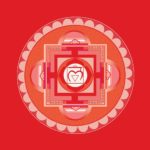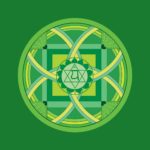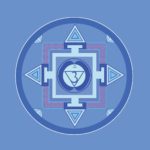What are chakras?
The word 'chakra' is Sanskrit and means 'wheel' or 'whirlpool'. We can visualise a chakra as a vortex of energy that connects our body with our aura (light body). The chakras control the flow of prana (life energy) in our body. The concept of chakras is probably the most misunderstood topic in the spiritual world. It is a very complex system used in yoga, tantra, and Tibetan Buddhism and traditional Chinese medicine. Similar systems are known worldwide and have been passed on from generation to generation for millennia. In South America, the Chakras are called "Ojos de Luz" - Eyes of light. Read how to open chakras:
Cleansing chakras versus opening chakras
Many misunderstandings about the chakras arise because people confuse chakra cleansing with chakra opening. That's not the same! One is about removing unwanted energy, and the other is about raising awareness.
How can I cleanse my chakras?
Imagine a hot tub in a beautiful garden. You switched it off, and the leaves of the trees around it are floating on the water. Now you pick the leaves from the basin until the water is clean again. This is how chakra cleansing works. Energies that are stored in your chakras through negative emotions and events are filtered out. Cleansing the chakras is a simple exercise that anyone can easily do on themselves. You don't need a “miracle healer” for this.
How to open chakras?
It is a little more challenging to open the chakra. Imagine our hot tub again. The leaves are out, the water is clear. And now we turn on the whirlpool. Activity and energy come into play.
I have already met many people in my shamanic courses and sessions, who proudly claim that all their chakras are open. Some even said that every chakra is open, and only the heart chakra is closed. You will soon understand how absurd that is.
The way to higher consciousness
The system of chakras is a system that leads us to higher consciousness. You start at the bottom with the Mooladhara Chakra (root chakra) and work your way up chakra by chakra. This process is called the awakening of Kundalini in Yoga. Each chakra holds a new challenge, and when you master it, the chakra opens, and you enter a new level of consciousness. Once a chakra is open, it isn't very likely to close again. A fierce, profound event could lead to a chakra and all chakras above it to close again. I have never met anyone in my life who has lost his heightened consciousness again.
Yoga can support the opening of the chakras. There are separate exercises for each chakra. Through meditation, we can direct energy into specific regions and thus support activation. So leap - let's get started!
The seven main chakras
Mostly we hear of 7 chakras, but we have a lot more: In total, we have 114 chakras, 108 of which are on the physical level. That means we can work with 108 chakras, but the seven main ones hold significant challenges for us. If you work with these seven, you balance the other Chakras automatically. The seven main chakras lie along the Sushumna (energy channel or 'Nadi' along the spine) at the intersections of Ida and Pingla. Each chakra is connected to a particular energy frequency and can be assigned to a level of consciousness. All of our feelings, thoughts and perceptions are related to the energy in our chakras. According to the Chakras vibration, we can assign a colour, an element, and a Bija mantra (seed mantra)to each chakra. With the help of the colour, the mantra and the element we can feel, hear and see the individual chakras in meditation.
Mooladhara Chakra (Root Chakra)
Colour: red
Mantra: LAM
Element: earth
Sense: smell
Physical connection: excretory organs
Gland: Gonads (Testes & Ovaries)
The Mooladhara Chakra is located in the perineum (men) and the cervix (women). 'Mool' means root and 'adhara' means place. All human energy origins here: sexually, emotionally, mentally, physically and spiritually. It is the place where the Kundalini energy rests. This is often depicted as a curled-up snake that can be awakened through yogic practice. (Sanskrit: 'kundala' 'rolled, twisted'). To open this chakra, we need to overcome our fear of survival. It's about the instinct for self-preservation, basic trust, stability and vitality.
Yoga exercises for the Mooladhara Chakra: Mula Bandha and Ashvini Mudra (a contraction of the anal sphincters)
Swadhishthana Chakra (Sacral Chakra)
Colour: orange
Mantra: VAM
Element: water
Sense: taste
Physical connection: genitals, tongue
Grand: Adrenal gland
The Swadhishthana Chakra is located on the spine between the Coccyx and the Sacrum. 'Swa' means 'self' and 'sthana' means 'dwelling place' - "the home of the self". This chakra is related to gaining joy and security. To open the Swadhishthana Chakra, you must develop sensuality and creativity and overcome your fears. It is directly related to the unconscious. According to the tantric philosophy, all animal instincts and the potential to overcome them rest here. The Swadhisthana Chakra is blocked by feelings of guilt and can only be opened through self-acceptance and self-forgiveness. Opening this chakra can be very difficult as many painful experiences are released.
Yoga exercises for the Swadhishthana Chakra: Ashvini Mudra (a contraction of the anal sphincters) and Vajroli Mudra (contraction in the urinary bladder area).
Manipura Chakra (navel chakra, solar plexus)
Colour: yellow
Mantra: RAM
Element: fire
Sense: vision
Physical connection: digestion, metabolism
Gland: Pancreas
The Manipura Chakra is located on the spine at the level of the navel. It can be felt in the entire area from the lower abdomen to the ribs. 'Mani' means 'jewel' and 'pura' means city. This is where our energy and willpower lie. It is our fire centre and is responsible for ensuring that we can assert ourselves and realise our dreams. To open the Manipura Chakra, you have to take responsibility and control over your own life. Accept all aspects of your personality, including those that you don't particularly like. If this chakra is open, self-esteem and inner strength flood us. An awakened Manipura Chakra makes the body glow and free from disease.
Yoga exercises for the Manipura Chakra: Uddiyana Bandha, Agnisara Dhauti, Nauli Kriya and Kapalabhati
Anahata Chakra (Heart Chakra)
Colour: green
Mantra: YAM
Element: air
Sense: keys
Physical connection: heart, lungs
Gland: Thymus gland
The Anahata Chakra is located on the spine behind the sternum. 'Anahata' means' unbound'. This indicates the need to let go of the material measurements of success. This chakra is directly related to our hands and the ability to give and receive (not to be mistaken with "give and take"). It is the source of all of our emotions; from envy to unconditional love. The opening of the Anahata Chakra is accompanied by strong, unconditional love for everything. We open it up by bringing deep painful experiences to the surface and working through them. Overcome your sadness and loss that you have already suffered. It is a purification process that releases us from destiny and karma.
Yoga exercises for the Anahata Chakra: Bhramari pranayama, mantra meditation (So-Ham) and concentration on the heart
Vishuddhi Chakra (Throat Chakra)
Colour: blue
Mantra: HAM
Element: ether or light
Sense: hearing
Physical connection: throat, ears, throat
Gland: Thyroid gland
The Vishuddhi Chakra is located in the neck. 'Shuddhi' means 'purification'.This chakra holds power to purify the body of toxins. Furthermore, the Vishuddhi Chakra is connected with communication. To open the Vishuddhi Chakra, we need to learn to express our own needs. Speak your truth and leave behind the lies you tell yourself. Once the Vishuddhi Chakra is open, it gives us the ability to transform negative experiences into wisdom.
Yoga exercises for the Vishuddhi Chakra: Simhasana (Lion's pose), all pranayamas (mainly when you perform them with the bandhas)
Ajna Chakra (third eye)
Colour: indigo blue
Mantra: AUM
Element: no conventional element, but the principle of consciousness and duality, pure light
Sense: sixth sense, heightened understanding.
Physical connection: brain, skin
Gland: Pituitary gland
The Ajna Chakra [Agna] is located in the midbrain at the end of the spine. We feel it especially between the eyebrows centre on our forehead. The element of the Ajna Chakra is the mind. The mind is not located in our brain but in each cell of our body. This is where the supernatural abilities of advanced yogis have their roots, the sixth sense, and willpower and discernment. A thoroughly purified mind can open this chakra. Leave all illusions behind. In this way, one gains the ability to detach oneself from the world of opposites (duality) and recognise all things' unity. In Christian paintings, the halo indicates an open Ajna Chakra.
Yoga exercises for the Ajna Chakra: all inverted postures (especially Shirshasana = headstand), Balasana (child posture), Tratak, Kapalabhati Pranayama, concentration on Ajna Chakra, eye exercises and visualisation exercises
Sahasrara Chakra (crown chakra, crown chakra) 
Colour: none
Mantra: none
Element: none
Meaning: none
Physical connection: none
Gland: Pineal Gland
The Sahasrara Chakra is located at the vertex and a little above it. The symbol is a shining, thousand-petalled lotus ('Sahasrara' = 'thousand'). This shows its transcendent nature because the Sahasrara Chakra is beyond all symbols, mantras and colours. This chakra overcomes the limits of our material being and strives for transcendence. It cannot be associated with the physical body. Sahasrara is not a chakra, but the sum of all other chakras that transcend here. To open this chakra, we have to leave all attachments behind. Whoever opens this chakra enters the first level of enlightenment/ transcendence.
Yoga exercises for the Sahasrara Chakra: same as for Ajna Chakra.
Opening the chakras is a natural process. Everyone goes through it. Many will only open a few chakras in this life and continue working in the next life. However, some will already be able to open all chakras in this life and reach a very high consciousness level.
To learn more about the chakras and how to open chakras, visit our internationally recognised yoga teacher training or our intensive shamanism course.

